

copyright © Wartime Heritage Association
Website hosting courtesy of Register.com - a web.com company
Wartime Heritage
ASSOCIATION
Remembering World War II

Thomas Norman Kemp Beard
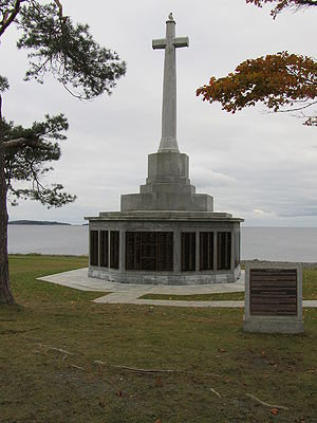
Name:
Thomas Norman Kemp Beard
Rank:
Midshipman
Service Number:
O5119
Service:
Royal Navy’s HMS Hood,
Royal Canadian Navy
Date of Birth:
May 16, 1921
Place of Birth:
Halifax, NS
Date of Enlistment:
August 25, 1939
Age:
18
Place of Enlistment:
Victoria, BC
Address at Enlistment:
Victoria, BC
Height: 5 feet 8 inches
Complexion: Dark
Eyes: Brown
Hair: Brown
Trade:
Student
Marital Status:
Single
Religion:
Roman Catholic
Date of Death:
May 24, 1941
Age:
20
Memorial:
Halifax Naval Memorial (Panel 5)
Commemorated on page 23 of the Newfoundland Book of Remembrance
Displayed in the Memorial Chamber of the Peace Tower in Ottawa on January 23
Thomas Norman Kemp Beard was the son of Commander Charles Taschereau Beard (1890-1950) and
Kathleen Adele (Kemp) Beard, of Victoria, British Columbia. His parents were married in Dover, England
October 13, 1916. He had two sisters, Pamela Monica and Kathleen Patricia.
His father served in the Second World War, coming out of retirement to command the armed
merchant cruiser (AMC), the HMCS Prince Robert, during the early part of the war. The Prince Robert and
crew captured the German merchant freighter Weser off the coast of Mexico. He later retired due to poor
health.
Thomas attended Shawnigan Lake School on Vancouver Island, British Columbia, and was later
trained as a Naval Cadet at Stadacona and Britannia in 1939. He served in H.M.S. Victory and then H.M.S.
Hood as a Midshipman.
He applied for Cadetship in the Royal Canadian Navy September 29, 1938. His father signed a
declaration of his consent that Thomas be admitted to the Royal Canadian Navy February 15, 1939 and he
completed his medical examination July 15 in Esquimalt, British Columbia before enlisting August 25,
1939.
He was stationed at the naval shore
establishment HMCS Stadacona beginning
August 25, 1939, and then at HMS Britannia
(the Royal Naval College in Dartmouth, Devon,
England) from September 10, 1939 to July 25,
1940. He was rated Midshipman on April 1,
1940, at HMS Britannia; effective May 1,
1940. It was noted, “he is apt to be
bullheaded and ready to do anything. He
takes charge well.”
He completed additional training at HMS
Victory (the main Naval Barracks on Queen
Street, Portsmouth Dockyards) from July 25 to October 25, 1940, and then was stationed aboard the
battle-cruiser HMS Hood on October 26, 1940.
Two days later, on October 28, the
Hood sailed to intercept the "pocket
battleship" Admiral Scheer, and again on
December 24, 1940, to locate the heavy
cruiser Admiral Hipper, but Hood failed to
find either ship.
In January 1941, the ship began a refit
that lasted until March; even after the refit
she was still in poor condition, but the threat
from the German capital ships was such that
she could not be taken into dock for a major
overhaul until more of the King George V-
class battleships came into service. Captain
Ralph Kerr assumed command during the
refit, and Hood was ordered to sea in an
attempt to intercept the German battleships
Gneisenau and Scharnhorst upon the refit's
completion in mid-March. Unsuccessful, she
was ordered to patrol the Bay of Biscay
against any breakout attempt by the German
ships from Brest. Hood was ordered to the
Norwegian Sea on April 19th when the Admiralty received a false report that the German battleship
Bismarck had sailed from Germany. Afterwards, she patrolled the North Atlantic before putting into Scapa
Flow on May 6, 1941.
Battle of the Denmark Strait
When Bismarck sailed for the Atlantic in May 1941, Hood, with the new battleship Prince of Wales,
was sent out to intercept the German ships before they could break into the Atlantic and attack Allied
convoys. The German ships were spotted by two British heavy cruisers Norfolk and Suffolk on May 23rd,
and the British ships intercepted Bismarck and her consort, the heavy cruiser Prinz Eugen, in the Denmark
Strait on May 24th.
The British squadron spotted the Germans
shortly after dawn, but the Germans were
already aware of their presence. The British
opened fire with Hood engaging Prinz Eugen,
the lead ship in the German formation, and the
Germans returned fire, both ships
concentrating on Hood. Prinz Eugen was
probably the first ship to score when a shell hit
Hood's boat deck, between her funnels, and
started a large fire among the rockets and
ready-use ammunition for the anti-aircraft
guns.
Just before 6:00 AM, while Hood was
turning to port to unmask her rear turrets, she
was hit again on the boat deck by one or more
shells from Bismarck's fifth salvo, fired from a
range of approximately 16 ½ kilometers. A
shell appears to have hit the spotting top, as
the boat deck was showered debris. A huge jet
of flame burst out of Hood from the vicinity of
the mainmast, followed by a devastating
magazine explosion that destroyed the aft part
of the ship. This explosion broke the back of
Hood, and the last sight of the ship, which sank
in only three minutes, was her bow, nearly vertical in the water.
Thomas Beard was one of 1415 men lost when HMS hood was sunk by the Bismarck. Only three
survivors were pulled from the water. They were Ordinary Signalman Ted Briggs (1923–2008), Able
Seaman Robert Tilburn (1921–1995), and Midshipman William John Dundas (1923–1965). The three were
rescued about two hours after the sinking by the destroyer Electra, which spotted substantial debris but
no bodies.
Of the 1415 casualties, there were sixteen Newfoundlanders considered British subjects before
Newfoundland joined Confederation, and four Canadians. The four Canadians on HMS Hood at the time of
its loss were Midshipman Thomas Norman Kemp Beard, Midshipman Francis Llewelyn Lloyd Jones, age 20
from Revelstoke, British Columbia), Able Seaman Samuel Charles Milburn, age 18, born in Halifax, and
Midshipman Christopher John Birdwood Norman, age 19 from Victoria, British Columbia.
Three are remembered on the Halifax Naval Memorial in Point Pleasant Park in Halifax, Nova Scotia
and Samuel Charles Milburn is remembered on the Portsmouth Naval Memorial, England.
The Bismarck escaped May 24th, but was leaking fuel and attempted to escape to a German-held
French port. Two days later, it was sighted and crippled by Swordfish torpedo bombers of the Royal
Navy’s Fleet Air Arm from the carrier HMS Ark Royal, and was subsequently intercepted by British warships
May 27, 1941 and heavily damaged. A command went out to scuttle the ship and it sunk shortly thereafter.
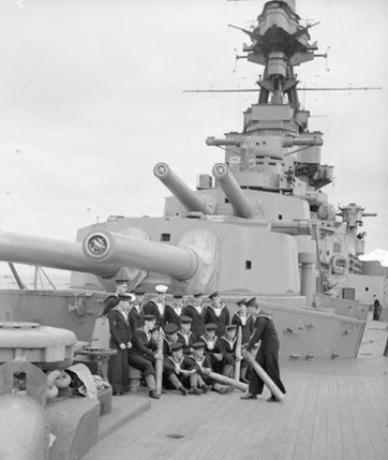
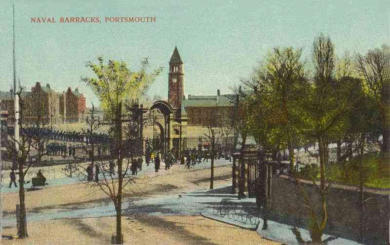
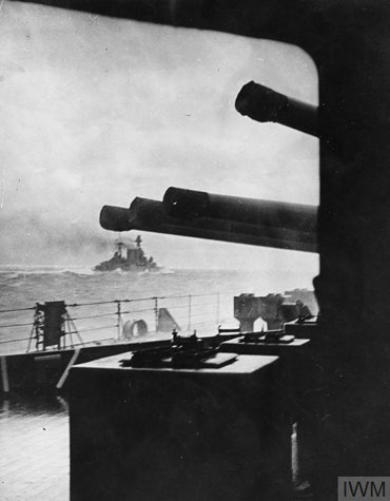
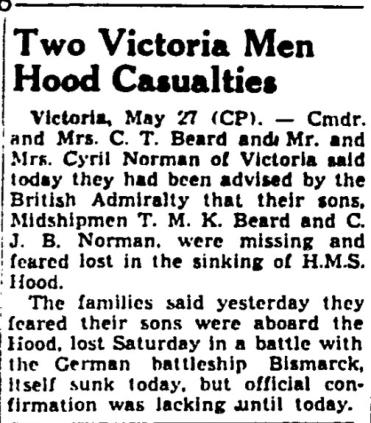
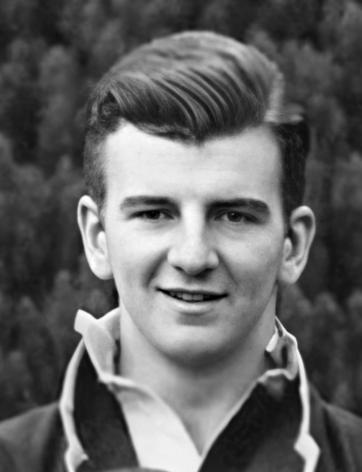


- World War I - Menu
- WWI Stories and Articles
- Photos - Yarmouth Soldiers
- Selection of World War I Songs
- WWI Casualties of Yarmouth, NS
- Those Who Served - Yarmouth, NS
- WWI Casualties Digby Co. NS
- WWI Casualties Shelburne Co. NS
- Merchant Mariners (1915) Yarmouth, NS
- Canadian Forestry Corps - Non Yarmouth Birth/Residence Enlistments
- US Draft Registry - Yarmouth NS Born


- World War II - Menu
- WWII Stories and Articles
- Telegraphist Air Gunners
- WWII Casualties of Nova Scotia
- US Casualties with NS Connection
- Far East/Pacific Casualties with NS Connection
- Merchant Navy Casualties Nova Scotia
- Nova Scotia WWII Casualties Holten Canadian War Cemetery
- D-Day Casualties - Nova Scotia
- CANLOAN Program Casualties - Nova Scotia
- Battle of the Bulge Casualties - Nova Scotia
- WWII Casualties Yarmouth NS
- Yarmouth Casualties - RCAF RAF Canadian Army WWII
- Yarmouth Co., Marriages WWII
- Casualties Non-Born/Residents with Connection to Yarmouth Co., Nova Scotia.
- WWII Casualties Digby Co., NS
- Non-Nova Scotian WWII Casualties Buried in Nova Scotia
- WWII RCAF Casualties Aged 16-18
- Brothers/Sisters Who Served - World War II













